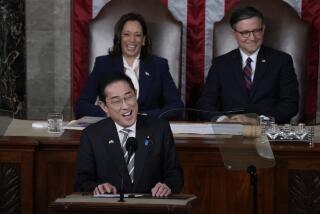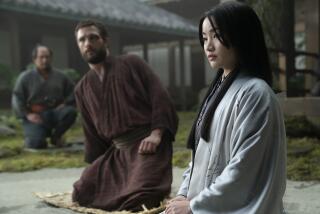Media : Japan’s ‘Manga’ Fantasies: Military Bolts Into ‘Comic’ Action : Cartoon books, funny pages and animated films reveal the mood of the country. One weekly sheds light on the debate about foreign policy and defense.
- Share via
TOKYO — In the chambers of Parliament, Japan’s leaders are locked in a hair-splitting debate over the country’s military destiny, with Prime Minister Toshiki Kaifu pushing for a broader interpretation of the postwar “peace” constitution that would allow him to send troops to the Persian Gulf.
On the pages of the popular magazine Comic Morning, a more dramatic version of history is being made--or at least made up.
The renegade Japanese crew of a special high-tech nuclear submarine has declared itself an “independent nation,” crippling part of the U.S. Pacific Fleet with brilliant torpedo shooting and forcing a sympathetic Japan to the brink of war with an arrogant America.
Don’t dismiss this as outrageous cartoon fantasy.
In a media phenomenon with few counterparts elsewhere in the world, the mood of contemporary Japan is revealed in its manga-- cartoon books, comic strips and animated films. Juvenile manga have grown up and followed maturing readers into mass-circulation middle age.
Specialized theme manga cater to readers with interests in sadomasochism, or to working women with romantic office fantasies. Commuters would seem empty-handed on crowded trains without publications like Comic Morning, a weekly variety magazine with a circulation of about 1 million--relatively modest by manga standards.
The story of the mutinous submarine, titled “Silent Service,” breaks all the taboos in Japan’s tedious national security debate. It also sheds light on forces at work beneath the surface of government policy.
The ruling Liberal Democratic Party now argues that the anti-militarist Japanese constitution permits “collective security” arrangements even as it forbids “collective defense”--whatever that means. The opposition accuses Kaifu of masking ominous revanchism in his proposed “United Nations Peace Cooperation Corps.” The press derides the prime minister as a toady to President Bush.
But for the background to the debate, just read “Silent Service,” where cartoonist Kaiji Kawaguchi, 42, vents a growing sense of resentment among Japanese toward what is sometimes perceived as American pushiness--in recurring trade disputes and now, with the Persian Gulf crisis, in foreign policy.
More than 2 million volumes of the cartoon series have been sold in compiled book form.
“One way to look at the secret to its popularity is that it is an outlet for people’s frustration about America’s ‘Japan bashing,’ ” observed an article on “Silent Service” in the Asahi newspaper.
Many Japanese complain that the United States has been hasty and seemingly trigger-happy in its response to Iraq’s Aug. 2 invasion of Kuwait--and unreasonable in its demand that Japan pick up part of the bill and contribute bodies to the U.S.-led multinational force protecting Saudi Arabia. (Japan has pledged $4 billion so far.)
“Is it fair for the United States to unilaterally decide on a policy,” a senior Foreign Ministry official said privately, “and then demand that we help pay for decisions we weren’t even consulted on?”
“Silent Service,” now in its 99th weekly installment, begins with the United States and Japan jointly developing a state-of-the-art nuclear submarine, a cartoon echo of the real-life FSX fighter jet they have been building jointly amid no small amount of nationalistic friction.
The submarine Seabeat is manned by a crew from the Japanese Maritime Self-Defense Forces, but it is placed under the command of the U.S. 7th Fleet, presumably because Japan cannot be trusted with nuclear firepower. Subservience to the Americans is unacceptable to the vessel’s idealistic skipper, Shiro Kaieda, who steals away with the boat on its test cruise to challenge the global power balance.
Kaieda, a square-jawed character with round, sparkly eyes, re-christens the sub Yamato--the tribal name for ancient Japan that was also given to one of the Imperial Navy’s mightiest World War II battleships--and boldly declares independence.
In scenes drawn with technical detail reminiscent of Tom Clancy, author of the submarine thriller “Hunt for Red October,” Kawaguchi has the Yamato chased by American and Soviet ships until it becomes the subject of a raging international dispute in and out of the U.N. Security Council. Japan, defiantly, recognizes Yamato’s sovereignty, and in a moment of desperation, the American President aims nuclear missiles at Tokyo and Osaka and threatens his ally with military occupation.
“A lot of people in the mass media figure I’m some kind of right-wing fanatic,” cartoonist Kawaguchi said during an interview at his cramped home and workshop in western Tokyo. “But I think most of my readers know where I’m coming from.”
Kawaguchi described himself as an anti-nuclear pacifist, but said he decided to explore the taboo of Japan’s charting its own military course, independent from the United States, to get his readers thinking.
“I don’t think our present foreign policy truly reflects how Japanese feel,” Kawaguchi said. “Kaifu isn’t articulating his own vision or putting up $4 billion to realize Japan’s goals in the Middle East, he’s only acting under U.S. orders. You can’t even call that a foreign policy.”
Parallels to Shintaro Ishihara, the neo-nationalistic member of Kaifu’s Liberal Democratic Party in Parliament, are hard to resist. Ishihara gained international notoriety last year for his best-selling book, “The Japan That Can Say No,” in which he mocks American arrogance and advocates greater independence for Japan. Ishihara, a former novelist, reviewed Kawaguchi’s manga series for the conservative newspaper Sankei.
“To say the least, for me this is an exceedingly sweet and dangerous manga ,” Ishihara wrote, “but one that I cannot keep my eyes off.”
Yasuyuki Shin, Kawaguchi’s editor at Comic Morning, said the publisher was prepared for protests. But so far, he added, the response has been overwhelmingly positive from all quarters. “It seems everybody is interpreting the story in their own way,” Shin said.
Kaieda, the renegade submarine commander, may have a hidden agenda for superpower disarmament, but he has become a folk hero for the downtrodden and demoralized members of Japan’s forgotten military.
“I think these people are happy that their world is being illuminated a little bit after being left in the dark for so long,” Kawaguchi said. “Japanese are only now starting to think about what kind of military they have.”
Prime Minister Kaifu would send Self-Defense Forces personnel to the Middle East and other future trouble spots where peacekeeping forces are deployed under U.N. sanctions, but it’s still not clear whether they would be allowed to wear their uniforms, or carry side arms, or remain in their commands.
Legislation creating Kaifu’s proposed U.N. Peace Cooperation Corps must clear the upper house of Parliament, where the opposition holds a majority of seats, before it becomes law. The prognosis is not necessarily good.
Also, nearly half the respondents in an opinion poll conducted by the newspaper Nihon Keizai were opposed to sending troops abroad, and only 23% expressed approval for Kaifu’s plan.
Meanwhile, cartoonist Kawaguchi plans to wrap up his submarine series sometime next year, and he is not saying how it will end.
Taking a cue from Ishihara, who complained that a bootleg English translation of his book circulated in the United States, talks have already begun on a possible English translation. Several inquiries have been made on television and movie rights. Commander Kaieda may be Japan’s answer to Rambo.
More to Read
The biggest entertainment stories
Get our big stories about Hollywood, film, television, music, arts, culture and more right in your inbox as soon as they publish.
You may occasionally receive promotional content from the Los Angeles Times.










